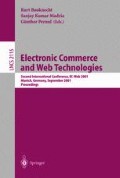Abstract
In this paper, based on CORBA security service specification[1, 3], we propose the authentication model supporting multiple domains for electronic commerce with an extension to the Kerberos[13] authentication framework using public key cryptosystem[15]. This proposed model supports the protection of the high-level resources and the preservation of the security policies of the underlying resources that form the foundation of various domains, between the Kerberized domains[14] and the Non-Kerberized domains. Also we achieved the flexibility of key management and reliable session key generation between the Client and the Provider using the public key cryptosystem.
Access this chapter
Tax calculation will be finalised at checkout
Purchases are for personal use only
Preview
Unable to display preview. Download preview PDF.
References
OMG, CORBA services: Common Object Security Specification v1.7 (Draft), ftp://ftp.omg.org/pub/ docs/security/99-12-02.pdf, 2000.
Object Management Group. CORBA/ IIOP 2.3.1 specification, http://sisyphus.omg.org/technology/documents/corba2formal.htm, 1999.
OMG Security Working Group, OMG White Paper on Security, OMG Document, No. 9, 1996.
Menezes, Van Oorschot, Vanstone, Handbook of Applied Cryptography, 2nd Ed., pp. 570–577, 2000.
OMG, Common Secure Interoperability V2 RFP, http://www.omg.org/techprocess/meetings/schedule/CommonSecureInterop.V2RFP.html, 2000.
A. Alireza, U. Lang, M. Padelis, R. Schreiner, and M. Schumacher, “The Challenges of CORBA Security”, Workshop of Sicherheit in Mediendaten, Springer, 2000.
DSTC, Public Key Infrastructure RFP, ftp://ftp.omg.org/pub/docs/ec/99-12-03.pdf, 2000.
Robert Orfali, Dan Harkey, Client/ Server Programming with JAVA and CORBA, John Wiley & Sons, 1997.
Andreas Vogel, Keith Duddy, Java Programming with CORBA, 2nd Ed., John Wiley & Sons, 1998.
Bob Blakley, CORBA Security: An Introduction to Safe Computing with Objects, Addison Wesley, 2000.
M. Humphrey, F. Knabe, A. Ferrari, A. Grimshaw, “Accountability and Control of Process Creation in the Legion Metasystem”, Symposium on Network and Distributed System Security, IEEE, 2000.
A. Ferrari, F. Knabe, M. Humphrey, S. Chapin, and A. Grimshaw, “A Flexible Security System for Metacomputing Environments”, High Performance Computing and Networking Europe, 1999.
John T. Kohl, B. Clifford Neuman, Theodore Y. Ts’o, “The Evolution of the Kerberos Authentication Service”, EurOpen Conference, 1991.
Massachusetts Institute of Technology Kerberos Team, Kerberos 5 Release 1.0.5. http://web.mit.edu/kerberos/www/.
M. A. Sirbu, John Chung-I Chuang, “Distributed Authentication in Kerberos Using Public Key Cryptography”, Symposium on Network and Distributed System Security, IEEE, 1997
M. Schunter, M. Waidner, “Architecture and Design of a Secure Electronic Marketplace”, 8 Joint European Networking Conference th, pp. 712-1–712-5, 1997.
M. Waidner, “Development of a Secure Electronic Marketplace for Europe”, ESORICS’ 96, Springer, Vol. 1146, pp. 1–14, Springer, 1996.
W. Diffie, M. E. Hellman, “New directions in cryptography”, IEEE Transactions on Information Theory, Vol. 22, No. 6, 1976.
T. ElGamal, “A public-key cryptosystem and a signature scheme based on discrete logarithms”, IEEE transactions on Information Theory, Vol. IT31, No. 4, 1985.
G. White and U. Pooch, “Problems with DCE Security Services”, Computer Communication Review, Vol. 25, No. 5, 1995.
T. Parker, D. Pinkas, SESAME V4 Overview, SESAME Issue1, 1995.
Joris Claessens, A Secure European System for Applications in a Multi-vendor Environment, http://www.cosic.esat.kuleuven.ac.be/sesame/, 2000.
Author information
Authors and Affiliations
Editor information
Editors and Affiliations
Rights and permissions
Copyright information
© 2001 Springer-Verlag Berlin Heidelberg
About this paper
Cite this paper
Chang, K.A., Lee, B.R., Kim, T.Y. (2001). Flexible Authentication with Multiple Domains of Electronic Commerce. In: Bauknecht, K., Madria, S.K., Pernul, G. (eds) Electronic Commerce and Web Technologies. EC-Web 2001. Lecture Notes in Computer Science, vol 2115. Springer, Berlin, Heidelberg. https://doi.org/10.1007/3-540-44700-8_17
Download citation
DOI: https://doi.org/10.1007/3-540-44700-8_17
Published:
Publisher Name: Springer, Berlin, Heidelberg
Print ISBN: 978-3-540-42517-5
Online ISBN: 978-3-540-44700-9
eBook Packages: Springer Book Archive

